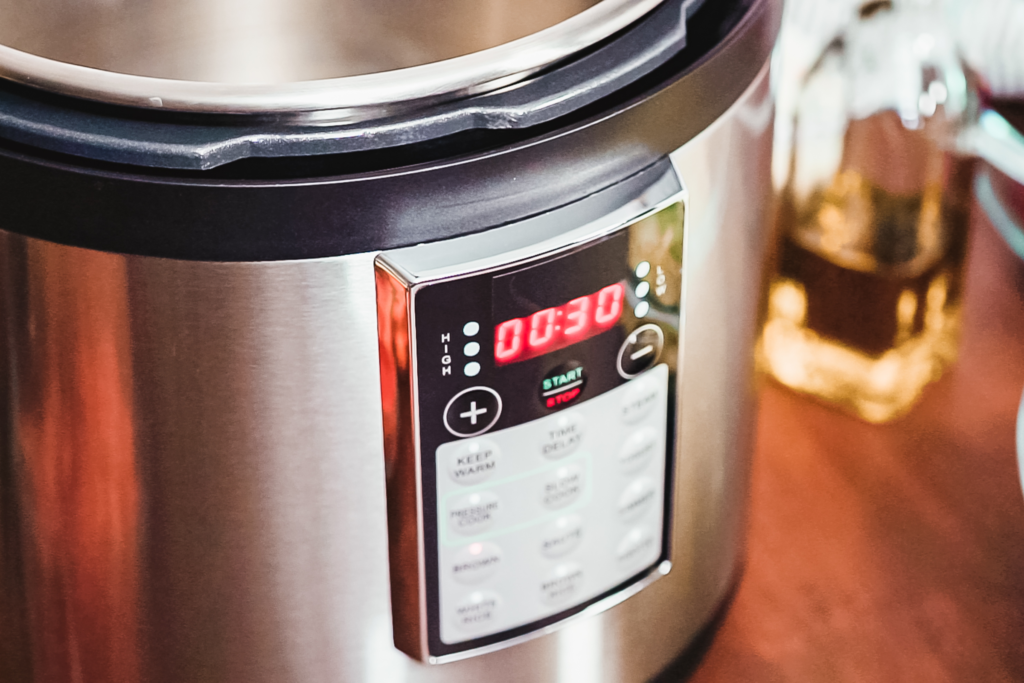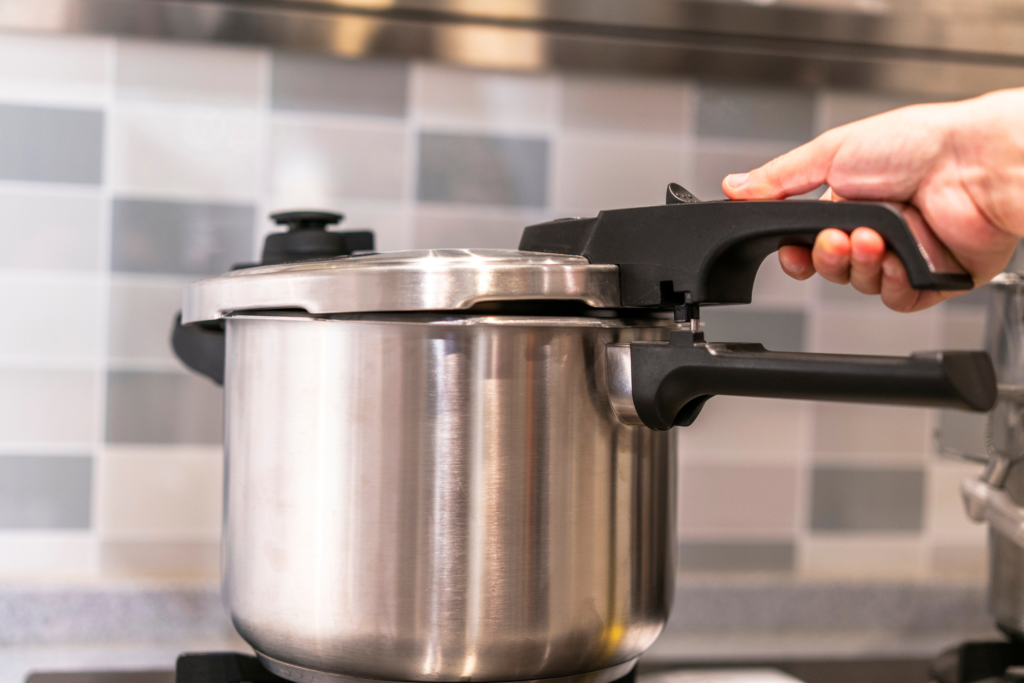My Instant Pot Is Hissing or Making Noise While Cooking (Is it Normal?)
Instant pots are a cheerful delight to the modern-day kitchen. They are a super-efficient and convenient way of electric cooking. Instant pots are versatile for exploring recipes involving crunchy roasting, steaming veggies, yogurt making, and much more. But what happens if you’re in the middle of a new recipe and your instant pot is hissing while cooking?
It’s normal for your instant pot to hiss a little during cooking as steam and pressure escape. The Instant Pot cooks food at high temperatures by creating steam on the inside and regulating how much stays during cooking. A hissing Instant Pot can be caused by not enough liquid, too high of a temperature, or a lid that isn’t fitted properly.
Keep reading for more information on why instant pots hiss and how to safely reduce the amount of hissing to a reasonable level.
Why is my Instant Pot hissing or making noise while cooking?
Instant pots are designed to make a variety of food using high pressures and temperatures in a compact space. The amount of pressure inside is what causes the hissing.
The instant pot uses a pressure cooker that generates heat under a closed lid. As a result, the temperature increases higher than the boiling point of water, and steam is compressed. The steam is released through the top of the cooker to reduce pressure inside, creating the hissing sound.
The instant pot accumulates steam to cook food faster and at high temperatures. When there is too much steam in the instant pot, it releases it through the safety valve and sometimes generates a hissing noise. The safety valve automatically opens to release the right amount of excess pressure.
Is my Instant Pot or pressure cooker supposed to make a hissing sound?
The instant pot lid is designed to expel internal pressure to avoid burnt food and potential accidents like explosions.
Your instant pot is supposed to hiss. As pressure increases, the safety valve opens to release excess steam. It functions similarly to a tea kettle, but the instant pot is different because it’s designed to regulate the amount of steam inside. If it starts hissing, it means it’s doing its job.
Instant pots release steam to reduce pressure which causes the hissing noise. It’s common to hear your pressure cooker hissing while cooking as it’s venting out excess moisture.
Is it safe for my Instant Pot to hiss?
Generally, an electric pressure cooker like the instant pot should only rattle or hiss briefly. Similarly, it’s expected to be silent and barely noticeable when it sizzles.
It’s safe for your instant pot to hiss. It regulates the steam inside and dispels excess vapors to reduce pressure. However, if the hissing sound persists throughout the cooking process, you might need to lower the temperature or check that it’s properly sealed. Consult the pot’s instruction manual for a detailed solution.
Electric pressure cookers use built-in hardware to keep their temperature and pressure at favorable levels during cooking. Your instant pot is supposed to be steaming and steaming while cooking.
Should an Instant Pot make noise while cooking?
While the instant pot makes some recipes a breeze, it can be quite noisy. Pressure cookers expel excess steam and pressure by removing it from the lid. You might ask yourself: is my instant pot supposed to be steaming while cooking, and does it make noise?
Yes. The instant pot is designed to make noises like rattling and hissing while cooking. These noises will likely continue throughout the process and are normal but should be addressed if the hissing or rattling becomes violent.
The safety valve on the sealed lid opens up, releasing excess pressure from the pot to regulate the cooking process. It’s good to pay attention and listen because some hissing noises, like a blaring one, indicate a technical issue that needs to be addressed immediately.

What causes my Instant Pot to hiss – high pressure Info
Instant pots can make loud and quiet hissing noises from the built-in pressure cooker, but what causes the hissing?
An attribute of every pressure cooker is its ability to withhold pressure in a sealed lid. The pressure and high temperatures cook food faster than traditional methods. When there’s too much pressure, the safety valve on the top opens, and steam escapes. As the excess steam is released from the pot, it produces a hissing sound.
It’s normal for your instant pot to hiss. Too much pressure inside is dangerous, and the expulsion of steam and heat is safe. Pressure cookers cook food thoroughly and evenly, especially recipes that call for oil.
How to stop my Instant Pot from hissing?
An instant pot hissing and steaming while cooking is a good thing in moderation – it means that the pressure inside is high. Some people might say that a pressure cooker is supposed to hiss to a certain extent.
You’re good to go as long as it’s not hissing loudly with steam bellowing from the valve throughout the entire cooking process.
Here are four solutions to stop your instant pot from hissing or if your instant pot sounds like it’s leaking.
1. Inspect your Instant Pot properly before cooking
If you observe that your Instant Pot makes a hissing sound while cooking, it’s possibly leaking around the top seal. It could also be that you forgot to seal the pressure valve before cooking or only sealed it partly.
Ensure the lids are properly sealed on your pot, and the valves are firmly secured.

Be sure to check for any further damages to the seal. Confirm the seal isn’t cracked, torn, or broken in any way. So you must be very vigilant and cautious.
Handy Tips: Other clues aside from hissing sounds, in this case, would be the instant pot takes an extended time to attain high pressures. Since a significant portion of accumulated steam is released through the opened lid or unsealed valve, it also slows the cooking process.
2. Add substantial liquid to your Instant Pot
To ensure your instant pot performs optimally, it’s essential to consider adding sufficient liquid to your cooking. For example, a few dishes and recipes would require more fluid than usual in your instant pot.
A pressure cooker uses steam to create high pressure that eventually cooks the food. The inner pot should have at least one to a half cups of liquid to reach a high enough pressure.
If the outcome after cooking results in a dish that is too runny or thin, a good remedy is to use the Sauté function, so the liquid reduces, and the food thickens. Alternatively, you can also use items that serve thickeners, such as flour, cornstarch, and potato flakes.

Quick little food science tip: Use other liquids aside from water to add flavor. For example, if you desire a vanilla taste, rather than just putting a vanilla spice into the pot, you could put the spice into a separate bowl, then add a little water/liquid and stir before adding it to the instant pot.
3. Careful with the temperature – it can build quickly
Reducing the heat on the stove-top heaters will help stabilize the pressure cooker, although this may take longer on an electric cooker. Unlike a regular pressure cooker, an electric cooker takes more time to decrease temperature and cool off its elements.
If your instant pot hisses more frequently than usual, you should use more than one heating element (preferably two) anytime you cook. This way, one heating element will help induce pressure in the cooker while the other helps lessen the temperature. You could as well use three for increased effectiveness.
4. Be sure to fit the sealing ring in position for pot sealing
While cooking, if you notice a hissing sound from steam escaping the corners of the lid, the sealing ring might not be positioned correctly or broken entirely. You can fix this by opening the instant pot and adjusting the sealing ring till it’s properly seated and there’s no visible vacuum.
A little test to confirm: Firstly, try to whirl the ring randomly, then spin the ring around the ring rack. If it swirls around the ring rack with the same effort you pushed with, it’s appropriately placed.
However, if it doesn’t rotate ideally, try to put it in position again, which should help. If you don’t get the expected results initially, continue to whirl the ring around its rack steadily. You would soon discover that it swirled with the same effort you pushed.
Why is my Instant Pot making a beeping sound?
Here are some common reasons why your Instant Pot might be beeping:
Common Reasons for Beeping:
- Start and End of Cooking: A beep often signals the start or completion of a cooking cycle.
- Button Press: A beep might sound each time you press a button to confirm that the input has been registered.
- Error Messages: In case of an error, like overheating or if the lid isn’t properly secured, the Instant Pot might beep and display an error code on its screen.
- Pressure Level: Some models beep when they reach the selected pressure level.
- Mode Change: When you switch from one mode to another (e.g., from Saute to Pressure Cook), the Instant Pot may beep to acknowledge the change.
- Steam Release: Certain models beep when steam starts to release naturally, or if you manually move the steam release handle to the venting position.
- Keep Warm Function: If your Instant Pot switches to the “Keep Warm” setting after cooking, it may beep to indicate the change.
- Timer Setting: Some models will beep to confirm that you’ve successfully set a timer.
- Safety Features: If the Instant Pot detects that the inner pot is missing or not properly placed, it may beep as a safety measure.
- Firmware Update: Though not common, some newer models may beep to indicate the progress or completion of a firmware update (if applicable).
Why is my Instant Pot making a clicking sound?
A clicking sound from your Instant Pot is generally not a cause for immediate concern and can be considered normal under certain conditions. However, it’s worth understanding what might be causing the noise. Here are some possible reasons:
Common Reasons for Clicking:
- Heating Element Activation: The clicking sound could occur when the heating element cycles on and off to maintain the desired temperature or pressure level.
- Pressure Building: As pressure builds up inside the pot, various components like the pressure valve may make clicking or popping noises as they move or adjust.
- Sealing Ring Adjustment: The silicone sealing ring may make a clicking or popping sound as it expands and seals, especially when the pot is coming up to pressure.
- Safety Mechanisms: The Instant Pot has multiple built-in safety features that may produce clicking sounds when engaged or disengaged.
- Steam Release: You might hear a clicking sound when steam is being released manually or naturally, especially if the steam release valve is shifting slightly.
- Mode Change: Changing between different cooking functions may also produce a clicking sound as different components activate or deactivate.
- Lid Lock: Some models make a clicking sound when the lid is properly locked into place or unlocked.
Summary of What causes a hissing Instant Pot
Instant pots are especially easy to use and efficient–their ability to cook at high temperatures makes them an excellent tool for a quick meal. Instant pots are relatively quiet for most of their cooking.
Instant pots are designed to expel pressure by removing excess steam. The hissing noise is a result of steam exiting the instant pot through the safety valve and is completely normal. Follow the instructions above to understand the situation better and solve the problem.
So should your instant pot make that little hissing shhh sound? Yes, it should. However, this should last only a short while and shouldn’t be loud.
Let Us Know How We’re Doing!
Did this expertly prepared resource answer your question?
Do you have another question about home maintenance, home improvement projects, home appliance repair, or something else?
Get more information, send in questions and keep the discussion going by contacting the I’ll Just Fix It Myself company customer service team at at 1-800-928-1490 or Email us at [email protected]
